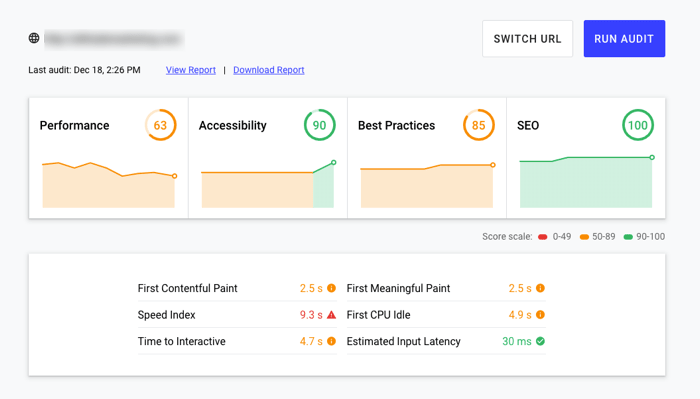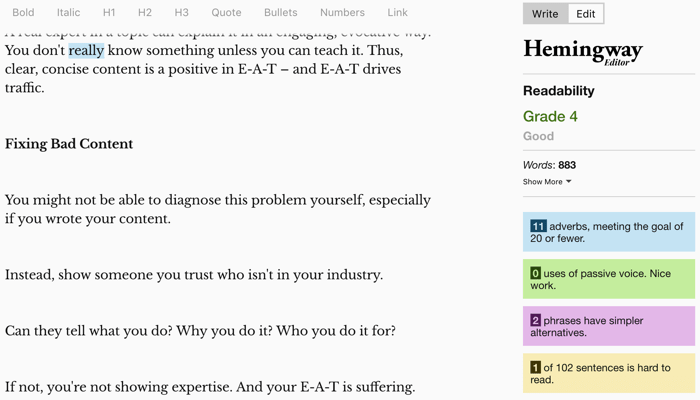You spent a lot of time and money building your website. But a few months – or years – in, the leads aren’t flowing like you expected. Why is your website not getting traffic?
In this post, we’ll break down the top four reasons why sites don’t maximize their user numbers. One is a bit technical, but you can start affecting all of them – and growing your traffic – today.
What Google Wants to See
Spoiler alert: What we’re talking about in this post is search engine optimization. (That’s “SEO,” for short.)
It used to be that SEO was a black box. Snake oil agencies would sell you magic cures, and then do stuff. (Or not.) Maybe you’d get results. But usually you wouldn’t.
Fortunately, SEO is a lot more clear these days. That’s because Google is sending us signals about what it wants to see.
No, we don’t know the algorithm. Nobody outside of Google does.
But we do have the guidelines that Google distributes to their Search Quality Raters. This is a group of 10,000 people worldwide tasked with providing feedback on search results. They can’t change rankings, but we have to believe that their ratings have an impact on search results.
The guidelines Google gives them are 166 pages long. And they mention “keyword” seven times.
So no, Google doesn’t want – or care about – your keywords. They want a site that demonstrates:
- Expertise
- Authority
- Trustworthiness
(That’s E-A-T, for short.)
Breaking Down E-A-T
If your website isn’t getting traffic, you need to focus on your E-A-T.
This isn’t a score we can quantify, like domain authority. It’s more ephemeral than that.
Here’s what each pillar of SEO E-A-T means:
- Expertise: Do you obviously know your topic well? Do you communicate answers in an engaging way?
- Authority: Should we listen to you? Are you a trusted expert, or a nobody talking out of turn?
- Trustworthiness: Should the user trust this site? Is it fast and clean, or full of typos? Is it secure?
Basic as they sound, those three tenants form the core of SEO in 2020. And if you’re not satisfying them, your site probably isn’t getting traffic.
Here are four reasons your site isn’t getting as many visitors as you want.
Reason #1: Your Site Is Too Slow on Mobile
Google wants to deliver a great experience to all users. It’s a business imperative that it do so.
When you use Google search, you’re asking it for a recommendation. It wants to send users to the best possible result. If they don’t like what they find, they’re going to turn to Bing, DuckDuckGo or another search engine.
And nobody likes landing on a website that’s slow to load.
Thus, Google is penalizing sites that don’t load fast, and rewarding those that do.
Think Mobile First
Here’s the catch: It’s only about mobile loading.
Google uses a technology called Lighthouse to measure site performance. (This has supplanted PageSpeed Insights.) It typically emulates a Nexus 5X smartphone to test sites.
Think about that.
It doesn’t help SEO if your site is blazing fast on desktop. Only mobile speed matters to the algorithm. And it’s true whether you get a lot of mobile traffic, or none at all.

Fixing Poor Site Speed
Fortunately, Lighthouse reports are extremely detailed. They break down exactly what’s slowing your site down and give you the basics of how to speed it up.
The ideal is to make your site AMP friendly. This framework strips out unnecessary elements and ensures a speedy mobile experience.
AMP is a tough standard, though. It forces you to reimagine everything you thought you knew about HTML and JavaScript. Chances are, you can’t get to native AMP. (It won’t work with WYSIWYG page builders, for instance.)
Most websites that aren’t getting enough traffic will need to take smaller steps. These include properly sizing images, removing unnecessary code and avoiding crazy fonts.
Let your Lighthouse report be your guide, and get to a minimum Performance score of 60. This makes your site look better in the eyes of the algorithm, and makes Google more likely to send you users.
Reason #2: Your Content Is Poorly Written
B2B sites are notorious for this one. They’re often written by engineers or other technical folks, making them:
- Wordy
- Dense
- Difficult to parse
- Focused on features, not pain points
- Overly sales-y
This type of content is a major reason why websites don’t get traffic.
Why?
Because users hate it, and Google does, too.
A real expert in a topic can explain it in an engaging, evocative way. You don’t really know something unless you can teach it. Thus, clear, concise content is a positive in E-A-T – and E-A-T drives traffic.
Fixing Bad Content
You might not be able to diagnose this problem yourself, especially if you wrote your content.
Instead, show someone you trust who isn’t in your industry.
Can they tell what you do? Why you do it? Who you do it for?
If not, you’re not showing expertise. And your E-A-T is suffering.
If your website isn’t getting enough traffic, start with your homepage and copy your content into Hemingway. That’s an app that measures your reading level and the complexity of your sentences.

You’re shooting for:
- A ninth-grade reading level, max. (That’s going to be hard for a lot of writers, but try.)
- As few adverbs and little use of passive voice as possible.
- Simple language.
- As few complex sentences as possible. (Stick to one or two clauses apiece. No semicolons.)
Hemingway isn’t a magic bullet for readable content. But it will help you deliver something that’s readable and effective.
Reason #3: You’re Not Producing Enough Content
There’s a reason that writing and publishing is important for tenure-track academics. An authority in a field writes a lot and provides plenty of answers.
Your site should be no different.
If you’re not producing new stuff at least once per month, you’re not showing your authority. If you know your stuff, you should have a sizable library of content. There’s no reason you wouldn’t!
If your blog is fallow and your website isn’t getting traffic, there’s a connection.
How to Produce More Marketing Content
The key to producing more content is coming up with better content ideas. If writing is a slog, you’re not going to do it regularly.
Here’s some good news: Marketing and SEO content doesn’t need to be difficult!
Here are some tips to break your writer’s block and encourage you to produce more, faster:
- Answer a question a prospect has asked you. If they wanted to know, others will, too.
- Break down a task step-by-step. How-to copy is easy to create and gets a ton of views.
- Give examples. Google (like users) loves examples.
- Offer checklists, cheat sheets and other useful content. If they can use it, they’ll want it.
- Don’t be afraid (on your blog) to get a little technical. Your homepage can’t be complicated, but a few posts at a high reading level is OK.
Reason #4: Your Backlink Portfolio Sucks
Backlinks play heavily into site authority. People love linking to authoritative sources. Thus, if you have a lot of quality links, you look more like an authority.
Problem is, most people do backlinks wrong. And if you screw up backlinks, your website might actually get less traffic.
Before we tell you how to improve your backlink portfolio, here’s what not to do.
When building backlinks, don’t ever:
- Buy links
- Trade links non-organically
- Get links from irrelevant or spammy sites
If you build a backlink portfolio any way other than by producing great content, Google will catch you. It will hurt you, not help your traffic.
You want more links, of course. But you want them to be relevant to you and your industry. Bad links are bad news.
Here’s how to use backlinks to get more traffic.
How to Build Your Backlink Portfolio
If your website isn’t getting enough traffic, head to a backlink checker tool and see what you’ve got.
SEO backlink tools include:
Run your root domain through the tool of your choice and see what comes out. Do some of your competitors, too.
What do you see?
If they have way more than you, you have work to do.
While you’re not going to buy links, there are strategies you can deploy to get them quickly. To build your SEO link portfolio, consider:
- Reaching out to executives’ alma maters and trying to get placements in alumni pubs
- Responding to HARO queries daily
- Finding places your competitors have guest blogged and asking for your own spot
- Making sure you’re listed in all possible relevant directories
Beyond that, the key to driving traffic through link building is content production. If you write more good stuff, links will come on their own.
Conclusion
If your website isn’t getting traffic, don’t panic! You’re probably not showing your expertise, your authority or how trustworthy you are.
Rather than freaking out, focus on:
- Site performance on mobile
- Your voice and clarity
- Producing more content
- Building an organic backlink portfolio
Driving more traffic through SEO takes time, but the investments you make today will pay off in visitors tomorrow.



